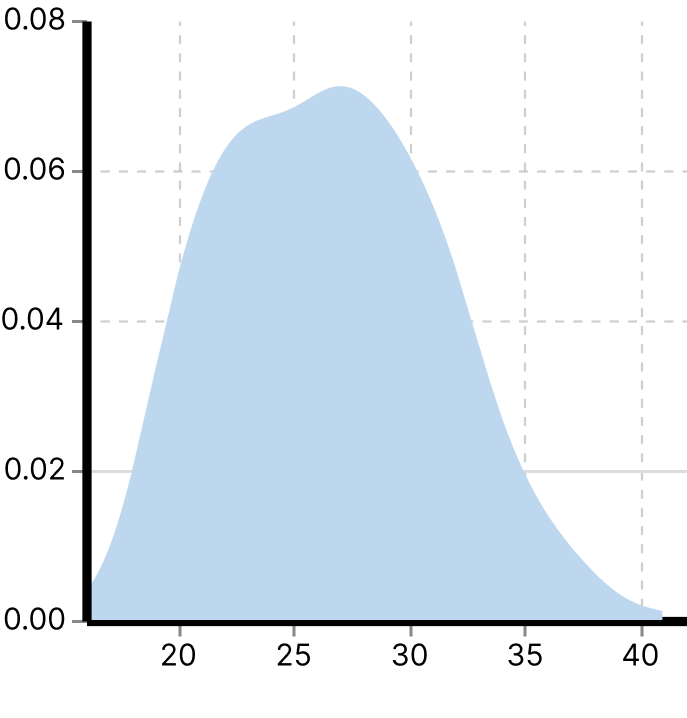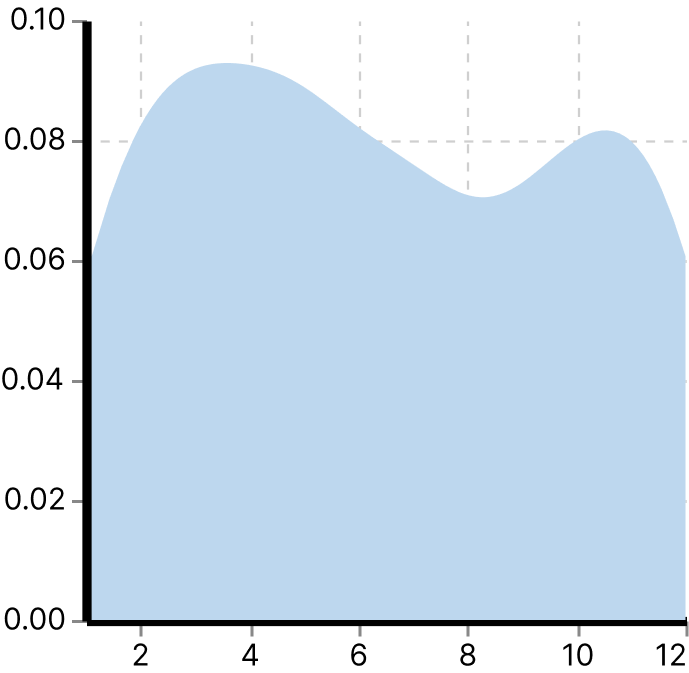

Why are Serie A Soccer Players born in January?
born in January?
It can't be a coincidence
There is a classic exercise that is often used to evaluate logical reasoning and problem solving skills during a job interview which requires you to answer the following question:
"What is the probability that in a class with 11 students, at least one of them was born in the month of September?"
(If you don't know the answer, try to take some time to think before moving on) And... drum roll. It turns out that it is not enough to take the number of months and divide it by the number of students, but it is necessary to think on multiple levels and consider the so-called Birthdate Effect.
If we go back for a moment to elementary school days, it will be easy for you to remember how many of your classmates' birthdays were more or less close to each other.
This is because the distribution of births is practically never uniform over the course of the year. The reasons are easy to understand, but to make it explicit, imagine having to conceive a child on the 15th of August returning from the beach in the middle of the afternoon in a typical and sultry Italian summer... not exactly ideal, right?
In fact, seasonal environmental conditions are the main reason why there are periods in which more people are born than others. For example, September is often associated with a peak in births and it is no coincidence that the Christmas holidays take place exactly nine months earlier.
However, if we change the context of reference and abandon the class in favor of a soccer team, things begin to take a different and unexpected turn.
"What is the probability that in a football team with 11 players, at least one of them was born in September?"
One would be inclined to think that roughly the same might apply among athletes as among students, but in reality the data would seem to say something completely different, and mere convenience of coupling has little or nothing to do with it in this case.
Let's take the Serie A footballers as a reference: try taking a look at some of your favorite footballers of the 2023-2024 season below. Do you notice anything regarding their date of birth?
Team
›
30
Defender
Brazil

07 January 1999
1
2
3
4
5
6
7
8
9
10
11
12
If you have chosen a sufficiently large sample, you will notice that the probability that the date of birth of the selected players is close to January is quite high.
In fact, if we visualize the birthday month of all the Serie A players of the 23-24 season, we can notice an evident shift towards January, accentuated by what looks like a real decreasing trend between player counts versus birth months.

It might seem like a coincidence, but if we extend the analysis to the 5 most important football leagues in Europe, it turns out that the situation doesn't change that much. In fact, if we divide the year into 3 quadrimester and count the number of births for each of them, we realize that the law remains surprisingly inviolate.
"Footballers who play at a high level are mainly born toward January".
And far more surprising is that none of these leagues have players born in the majority in the last 4-month period.


If you still think it might be a case, we can try for sake of diligence to also visualize some other player parameters such as height, weight or age. From what we can see below, these show no significant patterns and have, as might be expected, the classic bell shape typical of a normal distribution.
In practice, in a group of soccer players there will always be those who are taller, thinner or older, but generally most of them will present characteristics that are "average" and normal, with the exception of the month of birth which is affected evidently by some kind of suspicious influence.





This influence is a direct consequence of what is called The Matthew Principle. And here again, as in the case of the nascent of the interview, a multi-level reasoning needs to be done.
The Matthew Principle
To understand Matthew's principle fully, let's take as reference the story of two people born on January 1st and December 31st of the year 2000 respectively.
40 years
+ 364 days
40 years
+ 0 days
2.5%
Relative age difference
31 December 2040
undefined
undefined
undefined
undefined
As you will have understood, the further you go back in time, the more the difference between the relative age of two peers increases and this growing delta results into a series of small marginal benefits in everyday life.
These small advantages generated at an early age, accumulating, can transform into gradually larger advantages in adulthood, triggering a compounded effect that can be visually represented in the following way

Birth
Childhood
Adolescence
Young Adult
Adult
In the period between birth and adolescence, the child born on January 1st had 11 more months to grow, which made him taller, stronger and faster. The consequence is that the greatest, thanks to his physical growth, will have greater possibilities to be selected by the coach to play. By playing more he has a better chance of improving. By improving more quickly, he has a greater chance of being noticed earlier by talent scouts and so on... nurturing what is indeed a vicious cycle, where the line between a player's talent and the advantage he accumulates as a function of his age, blurs behind overly anticipated coach decisions and prophecies that then end up being self-fulfilling.
The phenomenon that triggers this problem associated with relative age is known specifically as the Matthew Effect, which in its financial interpretation states that "The rich become richer, the poor poorer".
Underdog payback
This principle is not only applicable to football, but to any high-level sport and to many other social areas where competition plays a fundamental role.
One would be inclined to think, why not break this kind of social pattern and adjust conventions when necessary to give everyone an equal chance of success? Obviously this is not such an easy issue to handle, and so much could already be done just by making youth coaches aware of this phenomenon, data in mind.
But one last point still remains open, which alone could partially justify maintaining the status quo and somehow enhance this sort of "casual injustice”. As often happens in nature, there is in fact a self-regulation mechanism that produces effects that in a situation of equilibrium may never appear.
Let's take for example these 3 players who were born in the months near the end of the year.
The players in question are undoubtedly among the most awarded footballers ever and are recognized by all, experts and non-experts alike, for their undisputed football qualities. This is because being born early means having a greater chance of being selected to play when young, But the "performance" thing then is a story in itself.
1/2

Kylian Mbappè
December 20, 1998


In fact, there are those who hypothesize, in contrast to the Matthew effect, the scenario of Underdog payback, in which smaller and physically less mature children develop a set of superior skill sets that allow them to emerge in highly competitive situations. And taking the players mentioned above as a reference, it is not difficult to believe in this theory.
After all, it is often the adverse conditions that delineate the hallmarks of the champion, capable of breaking the conventions that have been more or less implicitly inculcated in us, demonstrating that statistics can be overturned and fate can be written through one's actions.
Sources and Data


Danilo Fiumi
12/02/2024


Danilo Fiumi
26/12/2023


Danilo Fiumi
20/10/2023







